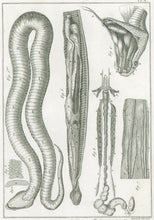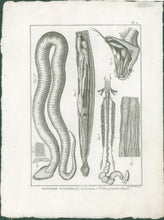M. l’Abbé P.J. Bonnaterre. (1752-1804) Pl. A. "Ophrologie Ve ordre, premières Figures." From Tableau Encyclopédique et Méthodique des Trois Règnes de la Nature, . . .: Erpétologie.
Paris: Pancoucke, 1789. Quarto. Copper plate engraving by Robert Benard on laid paper. Very good condition.
From a handsome French series on natural history, published during the period of great French thought, the late 18th century. Published in the same year as the commencement of the French Revolution, this work was produced with “the Approbation and Privilege of the King.” Bonnaterre adopted the term “Érpetologie” (Herpetology is derived from the Greek roots herpo and logos) from another naturalist, Klein, who had previously used it to designate that portion of the Animal Kingdom which includes snakes and reptiles.
These meticulously engraved plates show great detail of each of the species represented, where the creatures’ images are artfully arranged, even twined or knotted, several to a plate; a style also used by Dutch naturalist, Augustus Seba. These are finely worked and produced, and excellently preserved examples of 18th century naturalist scholarship.





